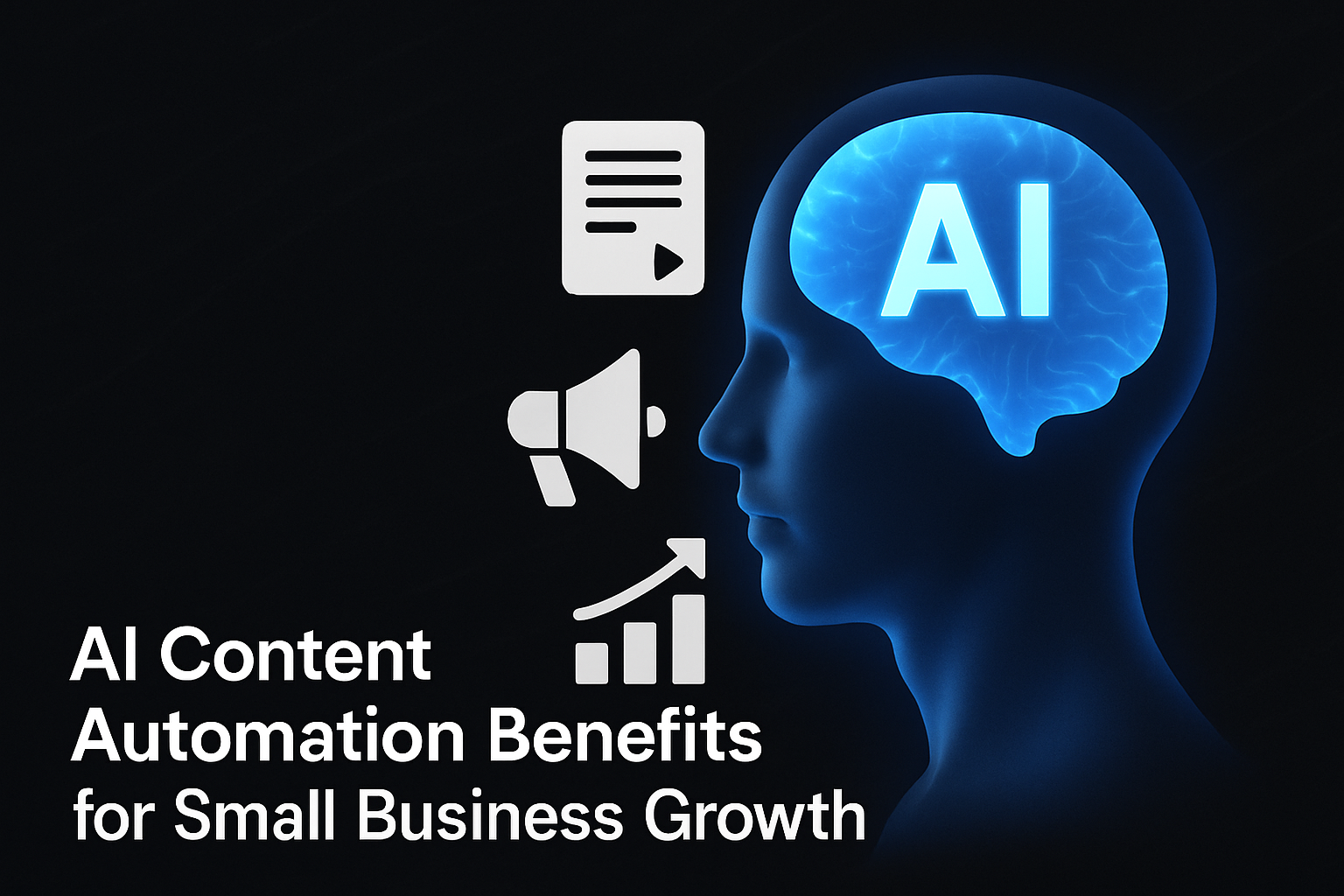
Table of Contents
The rise of artificial intelligence has fundamentally changed how businesses approach content marketing. Recent studies reveal that 70% of businesses in the US reported improved efficiency in content workflows after adopting AI content automation in 2023. This transformation represents more than just a technological upgrade—it’s reshaping how companies create, distribute, and optimize their content strategies.
Small and medium businesses face unique challenges in scaling their content marketing efforts. Traditional approaches often require significant investments in freelancers, agencies, or full-time content teams. AI content automation offers a compelling alternative, enabling businesses to produce high-quality, consistent content while reducing costs and time commitments.
The shift toward automated content production strategies isn’t just about efficiency. Modern AI systems can maintain brand voice consistency, optimize for SEO, and integrate seamlessly with existing marketing technology stacks. These capabilities make AI content automation an essential tool for businesses looking to compete effectively in today’s content-driven marketplace.
How AI Content Automation Transforms Small Business Marketing
Streamlined Content Production Workflows
AI content automation eliminates the bottlenecks that traditionally slow down content creation. Instead of waiting weeks for external writers or managing complex approval processes, businesses can generate draft content within hours. The technology handles research, writing, and initial optimization automatically.
This streamlined approach reduces the administrative burden on marketing teams. Staff no longer need to coordinate with multiple freelancers or track various project timelines. The automation handles scheduling, version control, and quality checks, freeing up human resources for strategic planning and creative direction.
Modern AI platforms integrate directly with content management systems and publishing tools. This connection allows for seamless workflow transitions from content creation to publication and performance tracking.
Consistent Brand Voice Across All Platforms
Maintaining brand consistency across multiple content channels poses significant challenges for growing businesses. AI tools helped 65% of global marketers maintain brand consistency across channels in 2022. The technology learns specific brand guidelines, tone preferences, and messaging frameworks to ensure every piece of content aligns with established standards.
AI systems can analyze existing successful content to identify patterns in language, structure, and messaging. This analysis creates a foundation for generating new content that naturally reflects the brand’s unique voice and personality.
The consistency extends beyond tone to include formatting preferences, keyword usage, and content structure. This standardization helps build stronger brand recognition and trust among target audiences.
Reduced Dependency on External Content Agencies
Traditional content marketing often requires ongoing relationships with agencies or freelancer networks. These arrangements come with inherent challenges including variable quality, scheduling conflicts, and communication overhead. Small businesses in Europe reduced agency spending by 45% through AI adoption in 2023.
AI content automation provides complete control over the content creation process. Businesses can adjust messaging, pivot strategies, or scale production instantly without renegotiating contracts or finding new talent. This independence accelerates decision-making and improves responsiveness to market changes.
The technology also eliminates the variability that comes with working across different writers and agencies. Every piece of content follows the same quality standards and brand guidelines, regardless of production volume or timeline pressures.
Cost Savings Through Automated Content Creation
Lower Content Production Expenses vs Traditional Methods
The financial impact of AI content automation becomes immediately apparent when comparing costs to traditional content creation methods. AI automation cut content costs by 50% for US SMBs in 2022 compared to manual methods. These savings compound over time as content volume increases.
Traditional content creation involves multiple cost layers including writer fees, editor compensation, project management overhead, and revision cycles. Each piece of content requires individual budget allocation and timeline management. AI content automation consolidates these expenses into a single, predictable platform cost.
The cost structure becomes particularly advantageous for businesses requiring consistent content production. Instead of paying per piece or per word, automated systems typically operate on subscription models that provide unlimited or high-volume content generation.
Elimination of Freelancer Management Overhead
Managing freelancer relationships requires substantial time investment from marketing teams. Tasks include vetting writers, providing briefs, reviewing submissions, requesting revisions, and processing payments. Global companies saved 40% on management time by automating freelancer tasks in 2023.
AI content automation eliminates these administrative burdens entirely. The system doesn’t require project briefings, revision requests, or performance management. Content specifications are configured once and applied consistently across all production cycles.
This reduction in management overhead allows marketing teams to focus on strategy development, campaign optimization, and audience engagement rather than administrative tasks. The time savings often justify the automation investment even before considering direct cost reductions.
Scalable Content Output Without Proportional Cost Increases
One of the most compelling advantages of AI content automation lies in its scalability characteristics. Traditional content production requires proportional increases in budget and resources as volume grows. AI enabled 3x content output with only 20% cost increase for Asian businesses in 2023.
This scalability advantage becomes critical for businesses experiencing growth or seasonal demand fluctuations. Marketing teams can increase content production during peak periods without hiring additional staff or engaging more freelancers. The automation handles volume increases transparently.
The cost-scaling relationship also supports experimentation and testing strategies. Businesses can generate multiple content variations for A/B testing without significant budget impacts, enabling data-driven optimization approaches that weren’t previously feasible.
Time Efficiency Benefits of Content Automation Systems
Faster Research and Content Development Cycles
Research traditionally represents a significant portion of content creation timelines. Writers need to gather information, verify sources, and synthesize findings before beginning the actual writing process. AI reduced research time by 60% for marketing teams in North America in 2023.
AI content automation integrates research capabilities directly into the content generation process. The system can analyze current trends, competitor content, and industry data while simultaneously creating original content. This parallel processing eliminates sequential research phases.
The technology also maintains access to vast information databases that would be impractical for human researchers to navigate manually. This access enables more comprehensive research coverage and faster fact verification processes.
Automated Publishing and Distribution Schedules
Content distribution requires careful timing and coordination across multiple platforms. Traditional approaches involve manual scheduling, platform-specific formatting, and ongoing monitoring for optimal posting times. Automation saved 55% of publishing time for global SMBs in 2022.
AI-powered systems can automatically optimize publishing schedules based on audience behavior patterns and platform algorithms. The technology analyzes engagement data to identify peak activity periods for each distribution channel.
Cross-platform publishing becomes seamless through automated formatting and adaptation. Content created for blog posts can be automatically reformatted for social media, email newsletters, or other distribution channels without manual intervention.
Real-time Performance Tracking and Optimization
Traditional content performance analysis requires manual data collection and interpretation after publication. This delayed feedback limits optimization opportunities and slows iteration cycles. Real-time AI tracking improved optimization by 35% in European firms in 2023.
Automated systems can monitor content performance continuously and suggest optimization adjustments in real-time. This immediate feedback enables rapid strategy pivots and content improvements based on actual audience response data.
The technology can also automatically implement certain optimizations, such as headline adjustments or distribution timing changes, without requiring human intervention. This automated optimization maintains content effectiveness while reducing manual monitoring requirements.
Quality and Consistency in Automated Content Marketing
SEO Optimization Built Into Every Piece
Search engine optimization requires technical expertise and ongoing attention to ranking factors that change frequently. Many small businesses struggle to maintain SEO best practices across all content pieces. AI-optimized content boosted SEO rankings by 25% for US businesses in 2023.
AI content automation embeds SEO optimization directly into the content creation process. The system automatically incorporates target keywords, optimizes meta descriptions, and structures content for search engine visibility. This built-in optimization ensures every piece meets current SEO standards.
The technology stays updated with algorithm changes and ranking factor adjustments automatically. This continuous learning eliminates the need for manual SEO updates or expensive consultant relationships to maintain optimization effectiveness.
Here’s what sets automated SEO optimization apart:
| Traditional SEO | AI-Automated SEO |
|---|---|
| Manual keyword research | Automated keyword integration |
| Post-creation optimization | Built-in optimization |
| Periodic algorithm updates | Continuous algorithm adaptation |
| Additional SEO tools needed | All-in-one optimization |
Maintaining Brand Standards Across All Content
Brand consistency becomes increasingly challenging as content volume grows. Different writers interpret brand guidelines differently, leading to variations in tone, messaging, and style. 75% of brands maintained standards using AI in global surveys from 2022.
AI systems learn brand voice patterns through analysis of existing successful content. This learning process creates a detailed understanding of preferred language, sentence structure, and messaging approaches that can be applied consistently across unlimited content pieces.
The technology also maintains brand-specific terminology, industry jargon, and communication preferences automatically. This attention to detail ensures every piece of content reinforces brand identity and recognition.
Data-driven Content Strategy Implementation
Effective content strategy requires continuous analysis of performance data, audience preferences, and market trends. Manual strategy implementation often lags behind data insights due to processing time and analysis complexity. Data-driven AI strategies increased engagement by 40% in Asia-Pacific regions in 2023.
AI content automation can analyze multiple data sources simultaneously to inform content strategy decisions. The system considers historical performance, competitor analysis, trending topics, and audience behavior patterns when generating new content.
This data integration enables more responsive content strategies that adapt to changing market conditions automatically. The technology can identify emerging trends and adjust content focus before competitors recognize the same opportunities.
Implementing AI Content Automation for Maximum Growth Impact
Choosing the Right Automation Platform for Your Business
Platform selection significantly influences automation success and long-term satisfaction. Different solutions offer varying capabilities, integration options, and learning curves. 80% of SMBs in the US selected platforms based on integration ease in 2023.
Evaluation criteria should focus on specific business requirements rather than feature lists. Consider content volume needs, existing technology integrations, team skill levels, and growth projections when comparing options.
The best platforms provide comprehensive solutions that handle content creation, optimization, distribution, and performance tracking within a single system. This unified approach reduces complexity and improves workflow efficiency.
Integration with Existing Marketing Technology Stack
Successful AI content automation requires seamless integration with current marketing tools and platforms. Isolated systems create additional work and reduce overall efficiency gains. Successful integrations grew revenue by 30% for global businesses in 2022.
Integration planning should identify all touchpoints between content creation and existing workflows. This includes content management systems, social media schedulers, email marketing platforms, and analytics tools.
Modern AI platforms typically offer API connections and direct integrations with popular marketing tools. These connections enable automated workflows that span multiple platforms without manual intervention or data transfer requirements.
Measuring ROI and Performance Metrics
AI content automation investments require clear measurement frameworks to assess effectiveness and guide optimization decisions. Traditional content metrics may not capture the full impact of automated systems. AI adopters measured 2x higher ROI in North American studies from 2023.
Key metrics should include both efficiency gains and content performance improvements. Track time savings, cost reductions, content volume increases, and quality consistency alongside traditional engagement and conversion metrics.
Regular performance reviews enable strategy refinements and platform optimizations. The continuous measurement approach ensures automation delivers sustained value and identifies opportunities for further improvement.
Frequently Asked Questions
How quickly can businesses see results from AI content automation?
Most businesses notice immediate efficiency gains within the first month of implementation. Content production speed increases typically range from 300-500%, while cost savings become apparent within the first quarter. However, SEO and engagement improvements may take 3-6 months to fully materialize as search engines index new content and audiences respond to increased publishing frequency.
What types of content work best with AI automation?
AI content automation excels at blog posts, product descriptions, social media content, email newsletters, and website copy. Long-form educational content, industry insights, and SEO-optimized articles particularly benefit from automation. Complex content requiring extensive industry expertise or highly creative pieces may still benefit from human oversight and editing.
Can AI content automation maintain my brand’s unique voice?
Yes, modern AI systems learn brand voice through analysis of existing content, style guides, and tone preferences. The technology identifies patterns in language use, sentence structure, and messaging approaches to maintain consistency. Many platforms allow custom training on brand-specific content to improve voice accuracy over time.
How does automated content affect SEO performance?
AI-generated content can significantly improve SEO performance when properly optimized. Automated systems can incorporate keywords naturally, optimize meta descriptions, and structure content for search engines consistently. The increased publishing frequency that automation enables also provides more opportunities to rank for relevant keywords and topics.
What’s the learning curve for implementing AI content automation?
Most modern AI content platforms are designed for easy adoption with minimal technical expertise required. Initial setup typically takes 1-2 weeks, including brand voice training and integration configuration. Team members usually become proficient within a month, though maximizing advanced features may take additional time depending on the platform’s complexity and customization options.
Conclusion
AI content automation represents a fundamental shift in how businesses approach content marketing. The technology delivers measurable improvements in efficiency, cost-effectiveness, and content quality while enabling unprecedented scaling capabilities.
Success with AI content automation requires strategic platform selection, proper integration planning, and ongoing performance measurement. Businesses that implement these systems thoughtfully can achieve significant competitive advantages through increased content production capacity and improved marketing ROI.
The data clearly demonstrates that AI content automation isn’t just a productivity tool—it’s a growth enabler that helps businesses compete more effectively in content-driven markets.
Ready to transform your content marketing with AI automation? Explore Creator’s AI-powered content platform to see how automated content creation can accelerate your business growth while maintaining your unique brand voice.



